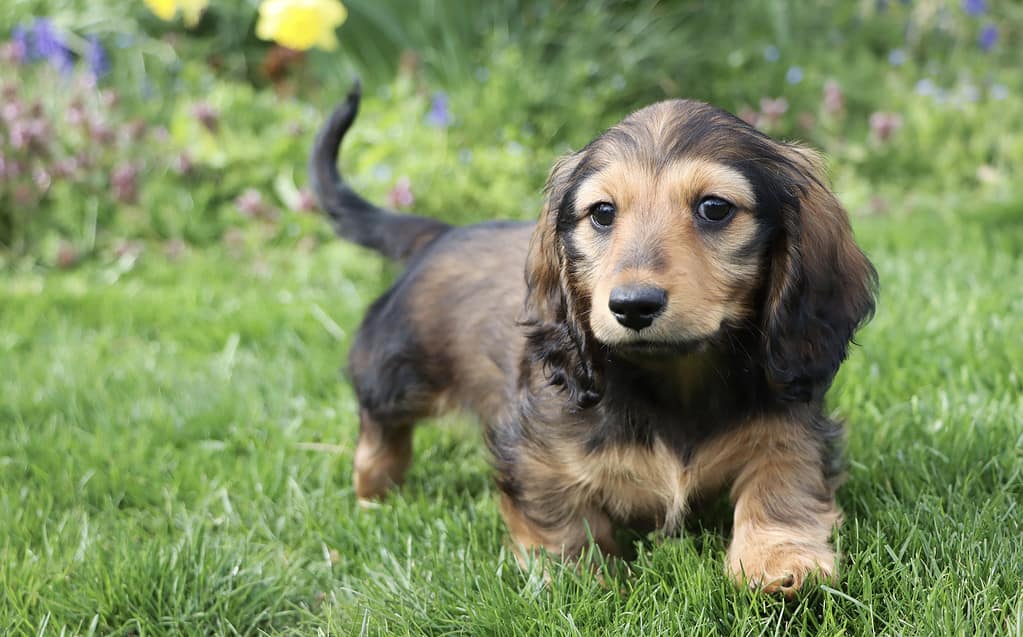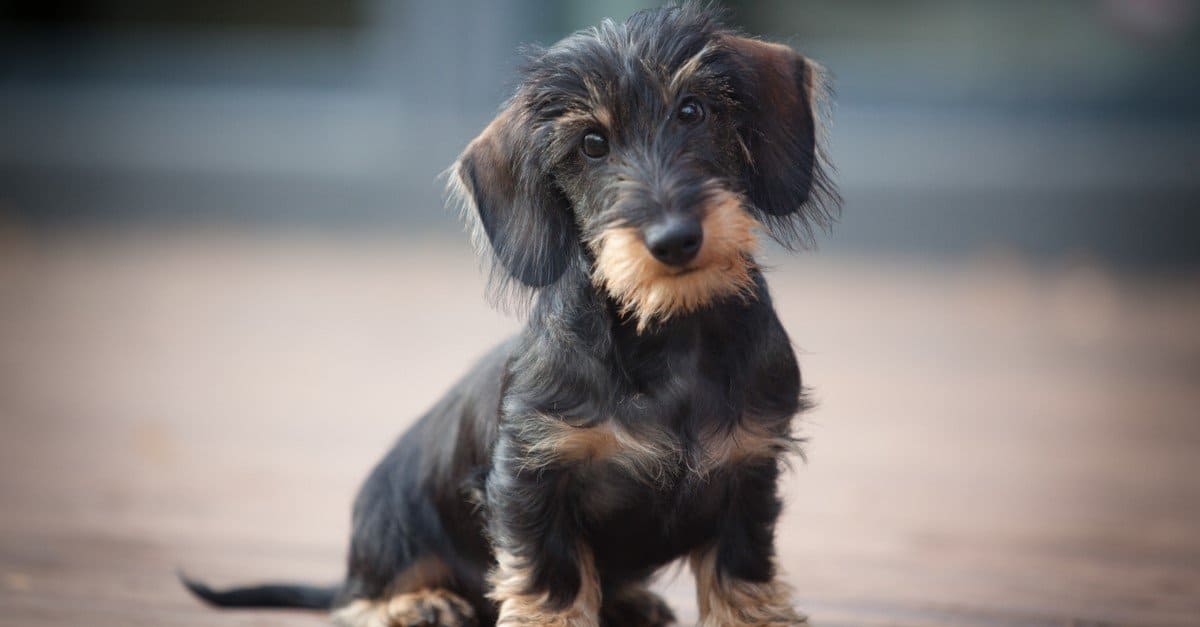Dachshund puppies are undeniably cute. Their elongated backs and floppy ears make them hard to resist. However, just like with any puppy, adopting one of these sausage dogs is a big responsibility that shouldn’t be taken lightly.
Whether you’re considering getting a Dachshund puppy or already have one, we’ll dive into everything you need to know about these puppies below. We’ll include adoption tips and tons of information on how to adopt one properly.
Adoption Tips

Longhaired Dachshund puppies aren’t as common as the smooth coat variety, but they are absolutely adorable.
©Sherri Simms/iStock via Getty Images
If you’re considering adopting a Dachshund puppy, it’s important to approach the process slowly and properly. You may want to consider adopting a dachshund from a rescue, which provides a home for dogs that wouldn’t have one otherwise. However, puppies can be hard to find at a rescue, and Dachshunds aren’t common rescue dogs to begin with.
Therefore, if you’re set on a puppy, you’ll often need to look elsewhere for one.
If you do want to adopt a dachshund puppy, consider finding breed-specific rescues near you. These have a much higher chance of having a Dachshund available for adoption, specifically. (Keep in mind, these adoption agencies are often harder to adopt from than a shelter.)
Of course, your local animal shelter does have a chance of having a Dachshund puppy. You can visit their location regularly and follow them on social media to keep an eye on the dogs they have available.
You can also use online adoption websites. There are many platforms that are dedicated to dogs in need, like Petfinder. Be wary of scams, which are sadly very common with pet adoption.
Just because you find a puppy available for adoption doesn’t mean that the dog is absolutely the best puppy for you. It’s important to learn about the dog’s temperament and history before deciding whether to adopt them or not. A good rescue agency will want to match the puppy with the right family, which often means asking you questions about your lifestyle and expectations.
Some agencies may require an interview and house visit, while others may only have you fill out an application. Sometimes, an adoption agreement is signed, which may outline what you’re required to do as the dog’s new owner.
No matter where you adopt from, understand that puppies have an adjustment period. They may be more likely to act out in the first few days they are adopted. Give them plenty of time to settle in. ‘
Purchasing from a Breeder

While Dachshunds are often kept as companion animals today, they were originally hunting dogs.
©Hannamariah/Shutterstock.com
In most cases, you’ll need to adopt a Dachshund puppy from a breeder. They’re just too challenging to find from a rescue. However, when choosing a puppy from a breeder, it’s important to choose a reputable breeder.
Professional breeders should prioritize the health and well-being of their dogs and adhere to ethical breeding standards. Most will do genetic health testing before breeding their dogs to prevent hereditary health issues from arising. You should ask about this health testing before adopting.
Responsible breeders will also start socializing the puppies before they are sent to their forever homes. Socialization works best when done very early. Therefore, the earlier yoru dog is started, the better. Ask about what experiences and people the dog is introduced to before you bring them home. If they spend most of their time in a kennel, they may not be very socialized when you bring them home.
Good breeders will also provide support and guidance for their clients before and after the puppies are brought home. Most have goodie bags that they send home with their puppies, which may make the transition less abrupt.
Tips for Finding a Responsible Dachshund Breeder
Start by researching breeders in your area. Often, an easy Google search is a quick way to identify what options you have. Sometimes, though, it makes sense to travel to find the perfect breeder for you. After you identify a few breeders, you can begin researching them more closely. Take a look at their application process and visiting rules.
You can also look at Dachshund breeder clubs for recommendations. Often, to be a part of these organizations, breeders have to follow certain guidelines. The AKC is a great place to start (they even have a puppy marketplace).
Arrange to visit the breeder or at least talk on the phone. You should always visit a breeder before deciding to adopt a puppy. However, some may only allow those on their waiting list to visit. In this case, you may want to arrange a phone call first.
Ask tons of questions while visiting or before. You should ask about the genetic testing and general breeding practices the breeder does. Ask about the puppy’s upbringing, too, as well as health testing. Mention health guarantees, too. Reputable breeders often provide these guarantees, as they know their puppies are healthy.
You can also ask for references. Some breeders may have reviews online (again, check Google), which can provide you with information from previous puppy buyers.
Red Flags to Watch For
There are many potential red flags to watch for. Usually, quality breeders will only focus on one or two breeds of dog at a time. If a breeder is offering five or more, it may be a sign that they’re just trying to make as much money as possible. Breeding dogs isn’t easy and requires an in-depth understanding of the breed. It’s hard to do that with several breeds at once.
Be cautious if a breeder has many litters at once, too. Sometimes, breeders may have a younger litter and an older one. However, having many litters at once means that the puppies won’t get the proper attention and may be a sign that their well-being isn’t being considered.
Always ask to see the mother and where the puppies are kept. If a breeder won’t show you, it’s a serious sign that they may be a puppy mill, which isn’t the sort of business you want to be supporting. A responsible breeder won’t care to show you where the mother and puppies stay.
If a breeder doesn’t ask you any questions or has requirements for adopting from them, it may be a poor sign. Quality breeders want to ensure that their puppies are in the best possible home.
Why Does it Matter?
It may be tempting to jump at the first Dachshund puppy on your newsfeed. However, reputable breeders are necessary to prevent health problems (which are sadly pretty common with Dachshunds).
You should support a quality breeder so that these practices are continued. While backyard breeders may be cheaper, they provide poor-quality puppies. You aren’t rescuing a puppy when you adopt from poor breeders. You’re encouraging them to continue and put more puppies in harm’s way.
Growth and Milestones
After bringing your puppy home, it’s important to understand their growth and milestones. That way, you can adjust your practices to match what your Dachshund needs at their particular life stage.
8 Weeks to 3 Months
At this point, most Dachshund puppies are sent to be with their forever homes. Therefore, you’ll probably bring your puppy home at this point.
This stage is essential for socialization. It’s critical to get your puppy around lots of different people and animals. This process helps ensure that they are friendly and not scared of everyone, which is sometimes an issue with this breed.
You should also begin basic training, including potty training and simple commands. The earlier you start training, the better off your dog will be.
3 Months to 6 Months
Your Dachshund puppy will start reaching their full size around this point. You should continue obedience and socialization, but your dog should begin mastering the basics.
If your dog hasn’t been spayed or neutered yet, you should start doing so now.
6 Months to 1 Year
You can start switching your dog to an adult food sometime in this zone. Dogs may begin acting up at this point, as they are often going through hormonal changes. Therefore, you should continue training and socialization, but don’t be surprised if your puppy backslides a litter but.
Milestones to Focus On
There are so many points you can focus on with a Dachshund puppy. However, there are some areas of their life where you can make a bigger difference than others.
For instance, proper socialization is the single most important thing you can do as a Dachshund owner. You want your dog to become a well-adjusted adult, and socialization is how you make that happen.
Of course, training is also important. We highly recommend getting yoru dog in group puppy classes as early as possible. These provide socialization and training, which helps you cover all your bases.
Your puppy will go through a teething phase between 3 and 9 months. During this time, they may chew more and be uncomfortable. Provide chew toys and train them to chew on them. You should puppy-proof your house if you haven’t already, as you don’t want your dog chewing on things they shouldn’t.
Caring for Your Dachshund Puppy
How you care for your puppy will affect them for the rest of their life. Once you bring your dog home, it’s important that you start caring for them properly right away.
This means choosing quality puppy food that meets their needs. Puppy food provides extra nutrients that puppies need due to their faster growth. A small breed formula is probably best, as the pieces will be smaller.
You should follow the feeding instructions on the container. Be wary about feeding your dog extra just because they seem hungry. Dachshunds are prone to becoming overweight, so don’t necessarily use their appetite to gauge how much they should eat.
Divide the dog’s meals throughout the day. Puppies have a hard time maintaining their blood sugar due to their smaller size. Therefore, it’s important to spread out their feedings to provide regular calories.
Dachshunds are an active breed, so you’ll need to provide daily exercise to keep them fit and healthy. Obesity is common, as we’ve previously explained, so exercise is really vital for this breed. However, they are prone to back issues. Therefore, you should avoid activities that require a lot of jumping and overexertion.
There are three types of Dachshund dogs, and each will have its own grooming needs. Smooth coats require less maintenance and typically only need the occasional brushing. Longhaired and wirehaired Dachshunds require more frequent brushing to prevent matting.
Start scheduling your puppy vet visits right away. Your dog will need vaccinations, even if their breeder provided them with their first few shots. Regular vet visits can also help prevent back problems caused by obesity and dental issues. Your dog’s teeth may need to be cleaned regularly to prevent more serious dental problems from showing up.
Be sure to also provide your puppy with the proper mental stimulation. These dogs are very curious, so it’s important to provide them with puzzle toys and play with them daily.
Ready to discover the top 10 cutest dog breeds in the entire world?
How about the fastest dogs, the largest dogs and those that are -- quite frankly -- just the kindest dogs on the planet? Each day, AZ Animals sends out lists just like this to our thousands of email subscribers. And the best part? It's FREE. Join today by entering your email below.
Thank you for reading! Have some feedback for us? Contact the AZ Animals editorial team.








